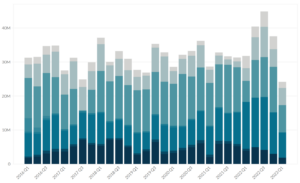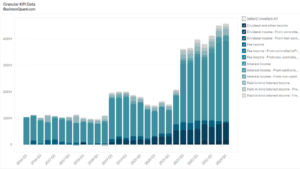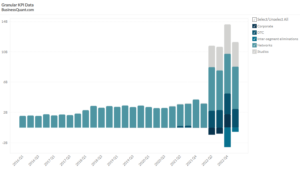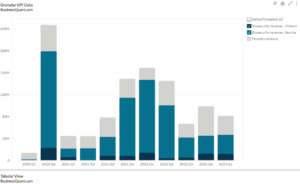
Dominos Pizza’s Revenue by Segment (2016-2023)
Exclusive Data
You need the Pro Plan to access KPI data
- Full access to the platform
- KPI data & segment financials on US stocks
- Financial data on thousands of stocks
- Download data in xlsx and csv formats
Pro Plan
$49 per month*
60% discount ends in:
.
About
More information
Subscribe to Pro or Enterprise plans to unlock this feature.
Contact the Analyst
Subscribe to Pro or Enterprise plans to unlock this feature.
Become a smarter investor today.
Access KPIs & Segment Financials on US stocks
This statistic highlights Dominos Pizza’s Revenue by Segment from Q1 2016 onwards, split across Domestic Stores, International Franchise, Intersegment Revenue, and Supply Chain, on a quarterly basis.
Dominos Pizza’s Revenue by Segment
The following table shows the company’s revenue by segment for Q3 2021, Q2 2021, and Q3 2020.
| Revenue by Segment | Q3 2020 | Q2 2021 | Q3 2021 | Revenue Mix by Segment for Q3 2021 |
| Supply Chain | $ 605.48 | $ 635.59 | $ 619.84 | 62.11% |
| Domestic Stores | $ 339.46 | $ 359.76 | $ 338.62 | 33.93% |
| International Franchise | $ 54.60 | $ 69.75 | $ 70.55 | 7.07% |
| Intersegment Revenue | $ (31.82) | $ (32.63) | $ (31.02) | (3.11)% |
| Total | $ 967.72 | $ 1,032.47 | $ 997.99 | 100.00% |
(All figures in millions, except percentages)
Supply Chain
During Q3 2021, the company’s supply chain segment generated about $619.84 million, or 62.11%, of the total consolidated revenues. It operates 21 and 5, dough manufacturing and supply chain centers, in the U.S. and Canada respectively. In addition, it operates one vegetable processing center, two thin-crust manufacturing centers, and one center providing equipment and supplies to its U.S. and specific multinational stores. In the future, Domino’s is also planning to invest in additional capacity initiatives and supply chain centers, along with one regional dough manufacturing and supply chain center that is likely to establish in the fiscal year 2022. This segment charters a fleet of more than 900 trailers and tractors and supplies over 7,100 stores located in the U.S. and Canada with quality food and other complementary items.
Third-Party supplies: A substantial amount of the company’s annual food spend goes with the third-party suppliers with whom the company maintains long-standing partnerships. These partners are mandated to meet the quality standards to ensure food safety. Some of the actions made by Dominos, to evaluate and review quality assurance, are on-site visits, third-party audits, and product evaluations.
Domestic Stores
This segment accounted for $338.62 million, or 33.93%, of the company’s total consolidated revenues during Q3 2021. It primarily comprises the company’s franchise operations, containing 6,185 franchised stores located in the United States. Additionally, it also manages a network of 375 company-owned stores in the United States. Direct operation of the company’s stores, significantly contributes to the company’s ability to act as a credible franchisor in the market. It also utilized these stores as test sites with respect to any technological innovation and promotion.
U.S. Franchise Profile: In 2021, the network of U.S. franchise stores was owned and managed by about 735 autonomous U.S. franchisees. The company’s franchise formula facilitates franchisees to acquire the benefits of the company’s brand recognition along with low initial capital investment to open new stores. An average U.S. franchisee operated almost eight stores and was noticeably involved in the franchise system for more than 18 years during 2021. In addition, 22 of the company’s U.S. franchisees operate more than 50 stores and 216 U.S. franchisees operate one store each.
U.S. Franchise Agreements: These agreements are made with the U.S. franchisees, in which the franchisees are granted the right to manage stores in a specified location for a period of ten years, which can be renewed for an additional period of ten years. The company had an approximately 99% franchise agreement renewal rate in 2021. In an ongoing standard franchise agreement, the company allocates a specific area of primary responsibility to each franchised store. In return, the franchisees are generally required to pay a 5.5% royalty fee on sales, along with certain technology charges.
International Franchise
In 2021, the company’s international franchise segment accounted for $70.55 million, or 7.07%, of the total consolidated revenues. This segment comprises a network of 12,288 international franchise stores in more than 90 international markets. The principal sources of revenues from these franchised stores to the company are royalty payments generated by retail sales, along with certain technology fees. The company’s recognized brand name, technological leadership, as well as the moderate requirement of capital expenditure to open the stores and system’s desirable store-level profitability, appeals to international franchisees. Stores in seven of the ten largest international markets, classified in terms of store count, are operated by master franchise companies that are publicly traded on a stock exchange. Store count in the ten largest international markets which account for about 62% of the total international stores are given below:
| Market | Number of stores |
| India (JUBLFOOD: NS) | 1,495 |
| United Kingdom (DOM: L) | 1,169 |
| Japan (DMP: ASX) | 882 |
| Mexico (ALSEA: MX) | 802 |
| Australia (DMP: ASX) | 724 |
| Turkey (DPEU: L) | 605 |
| Canada | 568 |
| South Korea | 475 |
| China | 472 |
| France (DMP: ASX) | 457 |
Intersegment Revenue
Intersegment revenues include sales of equipment, food, and supplies from the company’s supply chain segment to the Company-owned stores in the U.S. stores segment. These revenues are determined on the basis of the current market price.
About the Company
Founded in 1960, Domino’s is the biggest pizza company in the world having more than 18,800 locations across 90 markets around the world. The company is headquartered in Ann Arbor, Michigan, and has an employee count of over 13,500. Its common stock is traded on the “New York Stock Exchange” under the ticker symbol “DPZ”. It operates through its three reportable segments namely U.S. stores, supply chain, and international franchise.
More data on US Stocks

Our Plans
Always know what you’ll pay. No hidden costs or surprises.
- Annual
- Monthly
60% discount till April 30
Pro
For serious investing
-
Company KPI data Access segment financials, non-GAAP metrics and KPI data from presentations and filings. Examples include financials by segment / region / product category, AT&T's broadband subscriber trends, Tesla's deliveries by model and lots more.
-
Stock research tools Features include : stock screener, stock comparison, industry financials, stock warnings, advanced charting tools, timeseries tables, scatter charts, financial statements, stock reports, SEC filings, stock ratings, institutional and insider ownership data. There are 200+ financial items and ratios on thousands of US stocks.
-
Industry data & tools Access premium operating data on 40+ industries. Examples include market share, smartphone shipments by vendor, subscribers by wireless carrier, historical gold production. There are 20,000+ such statistics.
Enterprise
For tailored workflows
-
All of Pro plan Get unfettered access to all our dashboards and dossiers.
-
Custom built features Get tailored dashboards built specially for you , based on your set of requirements, to simplify your research workflow.
-
Admin billing Back-end documentation support and multi-seat licensing.
* Billed annually, local taxes extra.
60% discount on Annual plan
Pro
For serious investing
-
Company KPI data Access segment financials, non-GAAP metrics and KPI data from presentations and filings. Examples include financials by segment / region / product category, AT&T's broadband subscriber trends, Tesla's deliveries by model and lots more.
-
Stock research tools Features include : stock screener, stock comparison, industry financials, stock warnings, advanced charting tools, timeseries tables, scatter charts, financial statements, stock reports, SEC filings, stock ratings, institutional and insider ownership data. There are 200+ financial items and ratios on thousands of US stocks.
-
Industry data & tools Access premium operating data on 40+ industries. Examples include market share, smartphone shipments by vendor, subscribers by wireless carrier, historical gold production. There are 20,000+ such statistics.
Enterprise
For tailored workflows
-
All of Pro plan Get unfettered access to all our features.
-
Custom built features Get tailored dashboards built specially for you , based on your set of requirements, to simplify your research workflow.
-
Admin billing Back-end documentation support and multi-seat licensing.
* Local taxes extra.






